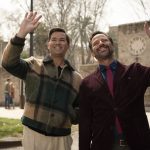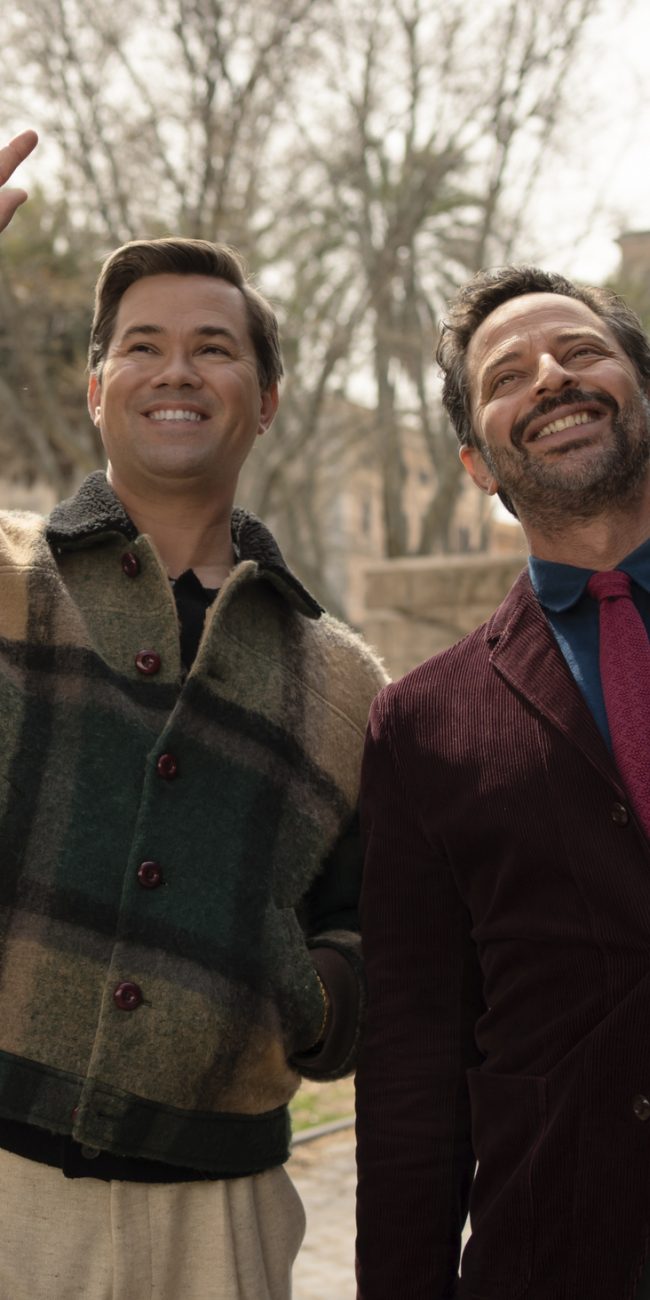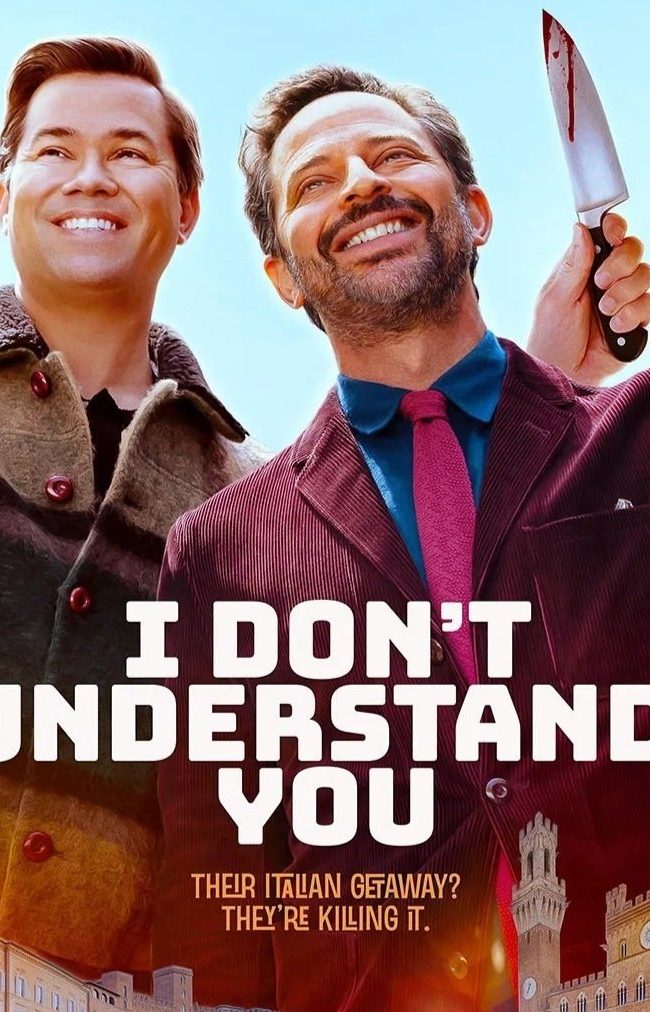A Conversation with Fawzia Mirza (THE QUEEN OF MY DREAMS)
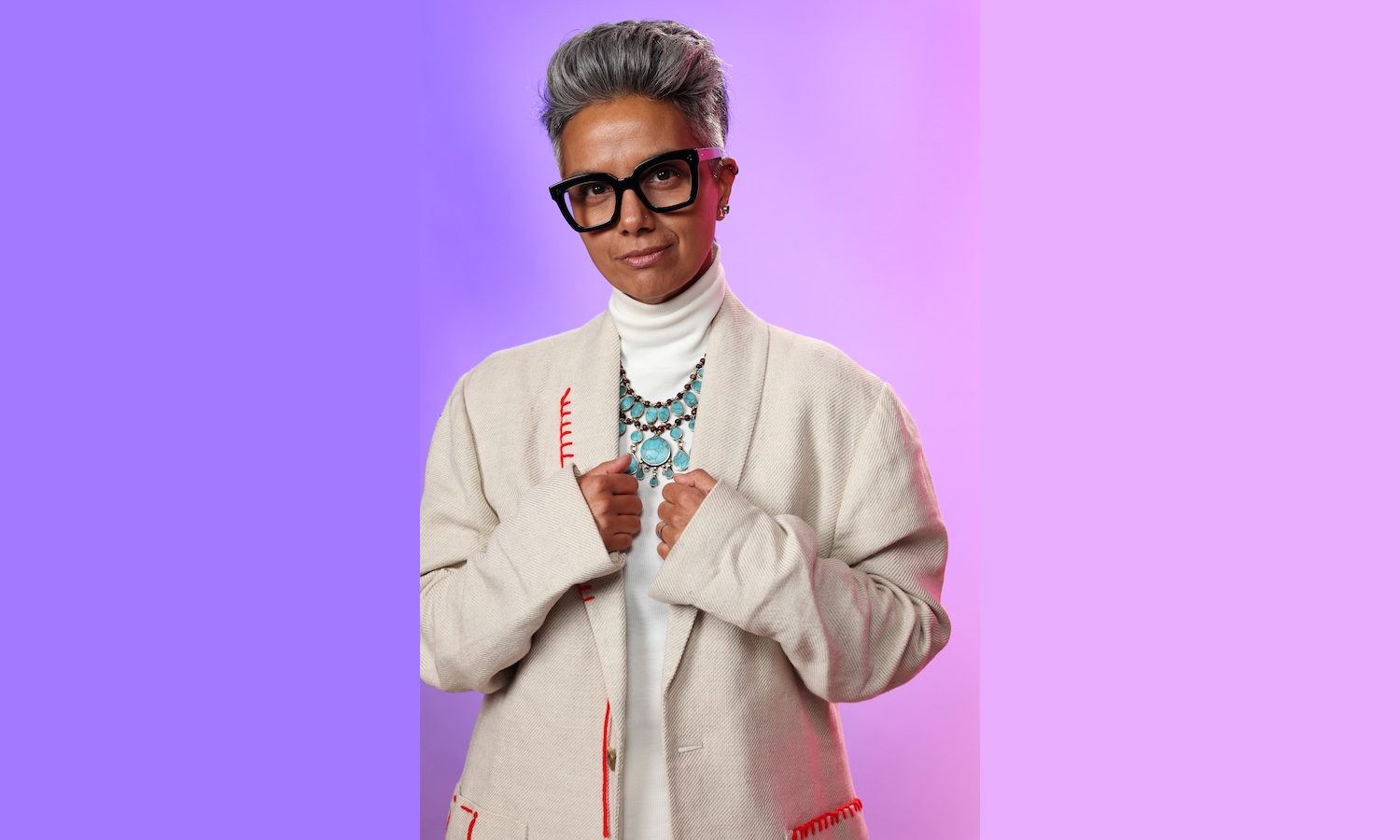
Filmmaker Fawzia Mirza’s feature directorial debut, The Queen of My Dreams (which I reviewed back at SXSW 2024), opens June 20, 2025, after a long and successful festival run. A charming meditation on identity and culture—queer, Pakistani, and Muslim—the film references many Bollywood tropes throughout its exquisitely crafted mise-en-scène, with special emphasis on the 1969 classic Aradhana and its star, Sharmila Tagore. Colors pop, music rings out, and love blossoms, over not one but many different time periods. I recently had a chance to speak with Mirza via Zoom, and here is that interview, edited for length and clarity.
Hammer to Nail: As I understand it, this feature, which is your first feature as a director, is an adaptation of both a previous short from 2012 and then a stage play of the same story. Could you walk me through that history and development of the narrative?
Fawzia Mirza: Yes. I had a short film called The Queen of My Dreams that I made in 2012. That world premiered at the Seattle International Film Festival and then went on to screen at over 40 or 50 queer festivals. I made that before I was a filmmaker. And that was a story I was struggling to tell about myself. I was struggling with this really private conundrum, I guess, of whether I could be queer and Muslim and love Bollywood romance. And so I dealt with it by making art and took this private struggle and made it very public. And actually, I was trying to make an art piece in my dream world because I was an actor at the time. It was going to be a bunch of this footage projected against a wall, there’d be a live performance piece, there’d be music.
And then a friend of mine named Ryan Logan, who was a filmmaker at the time, said, “I think this is a movie.” He helped me turn this art piece that I’d shot into a three-minute short film under the guise of like, “Can you tell a story in three minutes?” Making it really saved my life in terms of helping me process all those big feelings I was going through, and then sharing it at film festivals helped me see that there was a community out there that I could belong to that felt safe and like home and something I didn’t have before.
And then because I was an actor at the time and I was living in Chicago, the big dream for me was doing a one-person show. I was working for a company called Catharsis Productions doing comedy and educational theater work, and with their help and this incredible dramaturg named Brian Golden, I was able to develop this one-person show called “Me, My Mom, and Sharmila,” which was about me and my relationship with my mother told through a shared love of this Indian cinema heroine named Sharmila Tagore. The character’s name was Fawzia and we jumped around in more than three time periods, many time periods, many cities. And that was also really healing.
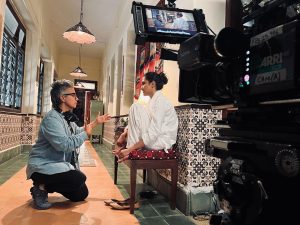
Filmmaker Fawzia Mirza on set
And I’d say the central question in that play was, “How do we become who we are?” And also the idea of how your parent used to be this way and what changed? That was super healing. And then I got to perform it in Chicago. We did a run, and then I did a run at some colleges and around the country and then I performed in other countries. I got to perform it in three cities in Pakistan—Lahore, Islamabad, and Karachi—which was also amazing. I made a documentary about the experience and it was around that time I started making more short films and some web series and then ended up making another feature film in Chicago called Signature Move, which world-premiered at SXSW. I starred in that and also co-wrote it.
And so I started to feel like I could write a screenplay and wanted to explore what else this short-film-turned-play could be: maybe it could be a movie and what would that look like? That was the beginning of the genesis of the screenplay, which still went through many iterations. At one point I had a co-writer and at another point I was working with a consultant and then at another point it was more like The Hours, the film that starred Meryl Streep. Not that my movie would star Meryl Streep, though she’d great, she’d be great. [laughs] But that really began the process of it. I decided to direct it in 2020. I had stopped acting. I decided to direct this movie and that was also a huge shift for me and life-changing moment in my career.
HtN: So, let’s talk about Sharmila. Thanks to you, I watched Aradhana. It was great fun. I wanted to see it after watching your film. And then I realized that Tagore also plays the mom in a film I’ve watched many times, Mississippi Masala.
FM: And she’s a star of Satyajit Ray’s films. She’s been acting since she was, like, 13. Iconic.
HtN: And she’s amazing in Aradhana, which has all the tropes that you then reference for fun. Were you always going to use that particular film?
FM: The first thread for me was the song “Mere Sapnon Ki Rani” from Aradhana. That song translates into “the queen of my dreams.” This song has been something I’ve been listening to since I was a kid. It’s one of those iconic songs that’s from a time that I didn’t live through or know about through personal experience, but it was such an iconic song. It’s been remixed on dance floors, everybody knows it. And so the song was the thing that I always thought about and was even the genesis of the short film, too. I dreamt of someone singing that song to me and I wanted to fall in love in that way.
And so I was like, “Who’s the queen? Who’s going to sing to me? Whose queen am I going to be?” This guy’s going to sing this song from a Jeep and I’m going to be reading the book on the train. That was the dream. And then when I started coming out as queer, I was like, “Okay, the woman is going to sing to me from the Jeep and I’m going to still be in my sari reading the book on the train.” [laughs] And as the short film kind of helped me find my way to this, I am the queen of my own dreams. You have to find that self-love. It’s not Bollywood, it’s not my mother’s.
And as I really reflected on it and looked at Sharmila Tagore’s character and who she was, she is a bit of a touchpoint for my mother. She was in the 1960s and in Pakistan, and Sharmila Tagore was in her prime in the ‘60s in India. Their hair, the style, the fashion, the vibes, the kind of rebellious nature … And I know rebellious can sometimes have a lot of weight to it, but it’s like you are unafraid and unapologetic about who you are and the choices you’re making. And that’s who I saw my mother to be in photographs and stories. And that’s who Sharmila Tagore seemed to be through her work. She was the first Indian woman ever to appear on the cover of a magazine wearing a two-piece bikini.
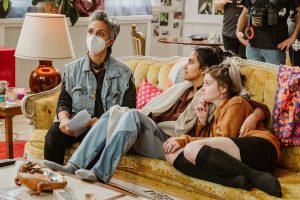
Fawzia Mirza on set with Amrit Kaur & Kya Mosey
So as I reflected on all those pieces, I started to feel this connection to a version of our mothers, one who stayed and one who didn’t, one who left, one who immigrated, one who didn’t. And then I just started finding so many other threads, as one does, especially by the time it came to the feature. There are just so many points of connective tissue that are so fun to play with, as you can see in the film in terms of family and motherhood and love and loss.
HtN: And then you bring that song into the end credits, as well, this time performed by the Sufi Qawwali group that returns, no matter the timeline, always with the same people. I love that group. How did you find them? And I love the fact that they’re the same, no matter the era.
FM: A hundred percent. Well, I can take no credit for finding them. I knew I wanted a Qawwali group, Sufi devotional music singers singing this poetry and interpretations of great poetry from the ages. Our producer Carol Noronha—our local Karachi producer—found them and they were willing to do it, both sing some of their original renditions of great poetry and take this song and create a rendition, as well. And they were on the rooftop, they were in a roundabout for hours and they were in this great park in Pakistan. And that music is really so key, I think, because it is music that’s timeless. They’re doing renditions of poetry that’s been heard and written hundreds and hundreds of years ago, and it’s like it keeps coming back. And the style of music is very deeply rooted in repetition and taking us to this ecstatic kind of place. It’s very circular. Thinking about history, this music repeats itself like a record on the turntable. That music is a portal and so it felt like there was a great connection to be made to how history repeats itself from generation to generation, mothers to daughters to mothers to daughters.
HtN: And what a perfect visual metaphor to then put them in the roundabout where you have people going around them; really brilliant. Speaking of brilliant staging and mise-en-scène, I really like your transitions, whether they’re quick swipes or camera moves as when Azra learns of her father’s death and then we cut to the plane. How did you work on those transitions? You also did these amazing montages, whether it’s the overhead of the Tupperware or the overhead of the food during the suitor sequences. How did you work with editor Simone Smith in those transitions and montages?
FM: Simone Smith as an editor is genius, and we tried everything in the edit to find the film, and the way she works and the way we were able to work together was just so seamless. I’m inspired by all kinds of movies. People want to define your work in one genre, but we’re not influenced or inspired by just one genre. And so I’m influenced by comedy and drama and Bollywood. And so people like Edgar Wright or Wes Anderson, who’s inspired by Bollywood films, or the incredible mother-daughter stories made by people like Greta Gerwig, or Lulu Wang with The Farewell. All of them are in the world of this film.
And I knew I wanted to create moments that for this film felt specific. I really wanted the B-roll to be a POV that was in this movie that made it this movie. We know what B-roll is: you’re setting location and place. But I asked myself, “How can I make this place feel like my POV?” And so I had to have people in all the B-roll and I wanted to feel all those swipes. I love a swipe in; I love a swipe out. Then we found this great connection to feeling like it’s photographs. These memories were like a slideshow, which I grew up with, meaning my dad used to put on the slideshow after dinner. We would go and have tea and dessert and … a slideshow. And he shared stories of his life. So that was really important.
And then I love comedy and even when something dramatic is happening—the quick cuts—I think you can see it in something like Requiem for a Dream. You can see it as a little bit of horror, fear, the eyes, the heroin, or you see it as comedy when Edgar Wright does it in Hot Fuzz, or Scott Pilgrim, Shaun of the Dead. And so I wanted that. I just love that. And so I was just like, “I’m going to try all these things and see what happens.” And I feel really lucky. It could have not worked, but I really wanted all of that to keep us moving and to show, again, repetition and things that keep moving. Maybe the vessel changes, the time period changes—you use a blender instead of grinding cilantro on a stone slab—but we’re still making the same thing. The ritual is the same no matter where you are.
HtN: Speaking of these amazing crew people helping you, you also have a wonderful DP [Director of Photography], Matt Irwin, and then your production designer, Michael Pierson. The look of the film is so strong. You mentioned Wes Anderson; I can see some of those compositions, but it’s also coming from you working with those people. What kinds of conversations did you have with somebody like Matt Irwin or Michael Pierson in designing the look of the film?
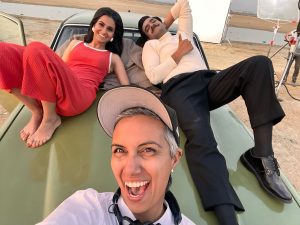
Fawzia Mirza in a fun outtake on set
FM: I wanted something vibrant. That was the number one conversation in our interviews and then all conversations thereafter: it had to be vibrant. And I wanted scenes to feel full in terms of their look. I didn’t want anything generic. I wanted specificity. And so Michael Pierson is a genius and Matt Irwin can make anything, and they both work together. And so one of the things we did in terms of the color and the look, Matt did some color testings of places and people and skin tones, and created a general LUT [lookup table, which determines the look of the footage] for the film that was really vibrant and rich, as a starting place. So that way we never were looking at raw footage on the camera. We were always remembering this is the world we live in.
The vibrancy to me was super important. I don’t know about you, but I have seen so many movies about Pakistan, or places like Pakistan, and they’re gritty and everything’s a struggle and “look at how hard it is for the people.” And I’m like, “Yes, it is hard, but also there’s so much joy.” So I wanted this movie to focus on the joy; even when there’s a death, it’s still a beautiful day out. And I wanted to embrace that because I’ve been telling queer, Muslim, brown stories since 2012 and have been very vocal and loud about the work I make centering these characters and centering our communities. And it is remarkable how few joyous stories there are. And so it continues to be something that I am actively seeking and striving for.
HtN: There’s a lot of joy in the film and I love that view of swinging Karachi of the late ‘60s. That was so much fun. Finally, I want to ask you about the cast. You have Amrit Kaur as your lead, and then Nimra Bucha, who I’ve seen in so much, including Polite Society and Ms. Marvel and other things. Hamza Haq, as the father, is great. And then let’s not forget the young actress playing the teenage Azra, Ayana Manji. How did you find them? It’s such a great cast. I also want to give a shout out to the other kids in that teenage time period, that birthday party scene and the school. They’re all wonderful. Please talk about the casting.
FM: The first person who was cast in the film was actually Hamza Haq, as Hassan. I had met him on Zoom for something related to, I think, the Eid holiday. And I thought, “Oh, I really like this guy,” and I knew his work and there’s something about him that I was really drawn to. And so we had a conversation and he expressed his connection to the script, to the story, how he’d been wanting to do something where he is channeling his own father, and also he has a daughter and he wanted to make something that he hadn’t gotten to do yet, with a father who has a daughter, and he’d love to play that role. And it was just so clear he got it. And so that’s how he came into the story.
And then we were casting in Canada—our funding came from Canada–so we were really looking for our number one and number two in Canada. I saw a bunch of really wonderful actors and Amrit just really stood out. She draws you in. And it’s a challenging role, so I needed someone who could also speak the language and could train for this. And she was really willing to do it and also had the stamina to leave and go to Pakistan and was excited about that, not just getting a role and shooting it in the city you live in or the next suburb down, but going to Pakistan and living there. And she also had the strength. Being a really great actor … there’s something athletic about it, as well; so incredibly athletic and she really had been training where she was just in the right form to do this movie. One of the things I wanted was somebody South Asian who could speak the language, but I also really wanted to cast somebody queer. And she shared that with me—and I am not sharing anything she hasn’t talked about—and it felt really beautiful and moving that this movie was in some ways a way for her to begin to share her queerness with the community and with others.
And then honestly, when I was thinking about who would play the mom … I’ve made other movies with mothers, such as my film in 2017, Signature Move, which starred Shabana Azmi, the legendary actor, who’s made 150-plus movies at this point and starred in Fire. And so I know that there’s a handful of actors who can play that role, speak the Hindi/Urdu language really fluently where it’s so sellable and can get the comedy. Shabana Azmi, obviously, lives in India. So we were very lucky to get her for my first indie film. But then for this one, I was obsessed with Nimra; I wanted her. I’d been thinking about all the women around the world who could play this role. And she just felt like she had it. And then when I met her—and she says this, too—it’s like we knew each other. So I was just like, “Yes, please. How do we get her?” She is an icon.
And then Ayana Manji—Rizwan Manji’s daughter—is another incredible actor. I know her dad, and I knew his kids were actors. And so her name came up and I was just like, “Would she be interested?” And she just nailed it and was so almost beyond her years in the way she approached it and her love for the story. And she had thoughts on the character, and they were good thoughts. I incorporated them into the movie and I think they made it better. And then of course the other lead, the grandmother, Gul-e-Rana, is an incredible actor based in Pakistan where she’s a known soap-opera star. And she just … you can’t create the energy that she just naturally evokes. There’s always a little bit of me that’s like, “Oh no, I’m in trouble.” And it is remarkable; I can’t believe we did it.
HtN: Well, you definitely did. It’s a wonderful, wonderful film. I am so glad I got to see it more than once. I wish you all good things with this release coming up on the 20th of June.
FM: Oh my God, thank you so much. How lovely talking to you.
– Christopher Llewellyn Reed (@ChrisReedFilm)





